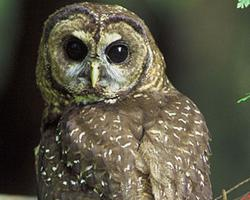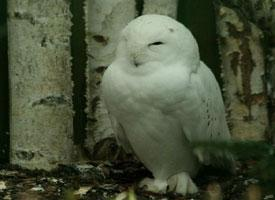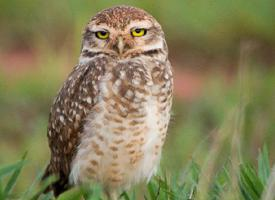
Poids et mesures
| Longueur | 45 cm |
|---|
Statut de conservation
| Menacé |
Description de l'animal
The Spotted Owl (Strix occidentalis) is a medium-sized owl notable for its distinctive appearance and the role it plays in the forest ecosystems of western North America. This species is one of the most emblematic symbols of the ancient forests it inhabits, and it has become a focal point in conservation efforts due to its sensitivity to habitat disturbance.Physical Description:
The Spotted Owl is characterized by its dark brown plumage, which is mottled with white spots on the head, back, and wings, giving it its common name. Its underparts are lighter, featuring a pattern of spots and bars that provide excellent camouflage against the backdrop of the forest. The owl's round face is framed by a set of dark brown facial disks, and it has large, dark eyes that are adept at absorbing light, enabling it to see in low-light conditions. Unlike many other owl species, the Spotted Owl does not have ear tufts. Adults typically measure between 16 to 19 inches in length, with a wingspan ranging from about 42 to 48 inches, and they can weigh between 1 to 1.5 pounds.
Habitat:
The Spotted Owl is found in a variety of forest habitats, ranging from wet coastal rainforests to dry, mixed-conifer forests. These habitats are characterized by dense canopies that provide the owl with protection and nesting sites, as well as a rich supply of prey. The species is divided into three subspecies, each adapted to specific habitat conditions within their range: the Northern Spotted Owl (S. o. caurina), the California Spotted Owl (S. o. occidentalis), and the Mexican Spotted Owl (S. o. lucida).
Diet and Hunting:
As a nocturnal predator, the Spotted Owl relies on its keen senses of sight and hearing to hunt. Its diet primarily consists of small mammals, such as flying squirrels, wood rats, and mice, though it will also consume birds, insects, and other small prey. The owl hunts from a perch, silently swooping down on its prey with precision.
Reproduction and Lifespan:
Spotted Owls are monogamous and tend to form long-term pair bonds. They typically nest in natural cavities in old-growth trees, using the dense canopy to conceal their presence. Females lay 2 to 3 eggs per clutch, which are incubated for about a month. The young are dependent on their parents for several months before they are ready to fledge. In the wild, Spotted Owls can live up to 10 years, though longer lifespans have been recorded in captivity.
Conservation Status:
The Spotted Owl is considered a species of conservation concern due to habitat loss, logging of old-growth forests, and competition from the invasive Barred Owl (Strix varia). Its populations have been declining, and efforts to protect its habitat are crucial for the species' survival. Conservation measures include managing forest resources, protecting nesting sites, and controlling Barred Owl populations in critical habitats.
The Spotted Owl's role as an indicator species highlights the importance of preserving old-growth forests not only for the owl itself but for the biodiversity of the ecosystems it inhabits. Its presence signifies a healthy, intact forest ecosystem, making it a key species in conservation efforts across its range.
Animaux similaires
Nouvelles photos d'animaux
Top 10 des animaux
- Dolphin gull (Leucophaeus scoresbii)
- Diana monkey (Cercopithecus diana)
- Moustached guenon (Cercopithecus cephus)
- Galápagos tortoise (Geochelone nigra complex)
- Russian tortoise (Testudo horsfieldii)
- Japanese macaque (Macaca fuscata)
- Stone loach (Barbatula barbatula)
- Greek tortoise (Testudo graeca)
- Common flying dragon (Draco volans)
- Colossal squid (Mesonychoteuthis hamiltoni)


